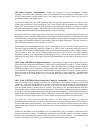30
16.9 Other Accuracy Considerations –Always use averaging if a level measurement is rapidly
changing its level like when measuring a radio carrier subjected to selective fading or SSB signals. This
will give representative average readings over a two second periods and make it easier on your eyes by
preventing racking of the display levels.
As discussed earlier, using the 10db measuring range will yield the greatest precision of .01db were the
100db range would have a lower precision of .1db. I have found on the air measurement of fading radio
signals will loose accuracy with the 10db automatic level mode with averaging on caused by constant
automatic measuring limit changes. The 100db range works much better for this and the .1db resolution is
still much greater than needed for measuring rapidly varying radio signals.
Automatic selection of a range’s upper limit will usually result in the most optimum selection for best level
measuring accuracy. However when tuning varying signals or different signals on a band, especially when
in the 10db range, using the entry manual limit setting option, the entry selection method will stop constant
auto ranging and resulting reduction in audio quality when fine tuning SSB signals. This and its reason is
fully discussed in Chapters 2 and 4, sections 2.2 and 4.11.
For maximum level measurement accuracy auto cal should always be on. However in some special cases
like when using the instrument’s tracking oscillator as a VFO to drive a transmitter, during the auto cal
cycle there will be around a 100Hz frequency shift up and down in the frequency of the tracking oscillator.
Then it’s best to leave auto cal off during transmissions but be sure to turn it’s on when changing
frequency or making level measurements for maximum accuracy. Also turn off auto cal when tuning or
monitoring the audio from a SSB signal since the SSB demodulation will be turned off during auto cal
cycles.
16.10 Using a HP3586 as a Signal Generator – After studying Chapter 14 on network analysis, you
should realize this instrument can be used as a audio or RF signal generator by using it’s 75 ohm 1 miliwatt
output from the Fo connector on it’s back panel. When it’s front panel is reading frequency with its
CENTER annunciator on this frequency is always exactly that of the signal from the Fo connector. With a
set of outboard 50 ohm attenuators and a 150ohm resistor in parallel with its Fo output, you can accurately
adjust the output from nearly 0dbm down as low as the capability of your attenuators. The attenuators
don’t even have to be accurate since you can calibrate their output signal using your HP3586’s level
detector.
16.11 Using a HP3586 to Receive and also Control a Transmitter – Here is an interesting idea
some of you may want to explore on how to use a HP3586A or B to operate transceive with an AM
transmitter. You could use the HP3586 as a SSB or AM receiver when controlling an AM transmitter’s
carrier. Each time you transmitted you would have to be in the low distortion selective measuring mode
with the speaker muted by turning down its volume. Then change to the noise/demodulation mode and
turned up the speaker volume to receive the other station. This could be cumbersome having to remember
to turn up or down the speaker and change mode each time you transmitted or received and if you forgot to
change modes for transmitting while working a SSB station, get the other SSB station real mad at you. See
section 10.3 of Chapter 10 and section 16.5 of this chapter to help understand how this would work.
You could also receive and tune the side band of an AM station the same way using the
noise/demodulation mode, then use the low distortion mode only while sending to move the Fo output to
the other AM stations carrier frequency. You could even use low distortion and the counter to first exactly
determine the other AM station’s carrier frequency and to transmit, and then use noise/demodulation only
to receive
Possibly the instrument could be modified to do this automatically using a computer or other device and
placing it into remote control. On HP3586’s back panel is the HP-1B connector for remote computer
control of the instrument that could possibly be used for this control function. To understand this
connector’s function you’ll need a copy of the instrument’s technical and service manual.


















